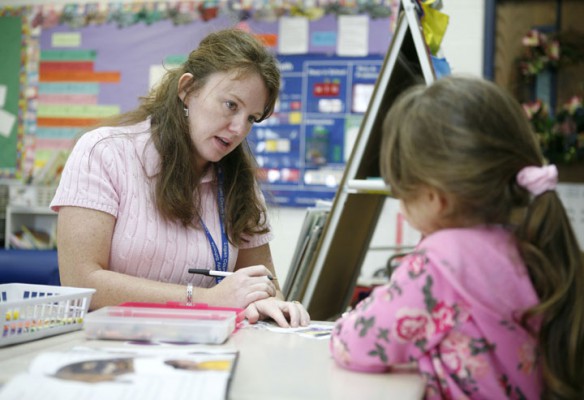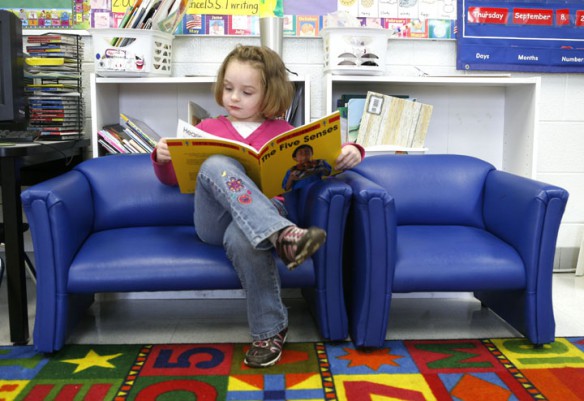
Kim Mooney helps kindergarten student Angel Bellar with an assignment about the five senses during class at Chandler’s Elementary School (Logan County). Photo by Amy Wallot, Sept. 8, 2011
By Susan Riddell
Fairy tales and other literary fiction are commonly used to introduce young students to reading.
But those types of texts are not always the best way to teach children about the natural world — a point reinforced for kindergarten teacher Kim Mooney during a recent lesson on the five senses.
“We were listing our five senses and the body parts. A little boy said he could hear with his mouth. I asked him to explain, and he just looked at me confused,” said Mooney, who teaches at Chandler’s Elementary School (Logan County). “Before students catch on to what is real and what is make believe concept, it is funny to hear what they think can really happen and what can’t.”
Educators like Mooney say helping students make distinctions between fact and fiction is critical to their future success in school and beyond. And it needs to happen early in the educational process.
That’s where the use of informational texts — which are emphasized in the Kentucky Core Academic Standards — can prove especially helpful, they say.
The standards define informational text, or explanatory writing, as text that addresses matters such as:
- types (What are the different types of poetry?)
- components (What are the parts of a motor?)
- size, function, or behavior (How big is the United States? What is an X-ray used for? How do penguins find food?)
- how things work (How does the legislative branch of government function?)
- why things happen (Why do some authors blend genres?).”
Informational texts are not limited to books. They also can include photographs, children’s magazines, websites and videos.
Learning becomes more innate for students exposed to informational texts early on according to Renee Boss, academic core branch manager with the Kentucky Department of Education’s Division of Program Standards.
“Young children need to be taught to read and use text features (headings, tables of contents, glossaries, electronic menus and icons) to learn new information,” she said “They need to be taught how to ask and answer questions about key details in informational texts. The standards specifically state that kindergarten students will do this ‘with prompting and support.’”
The state standards align with the National Assessment for Educational Progress (NAEP) framework for text types, Boss said.
“This means we look for a balance between reading of literature and the reading of informational texts. In grades K-5, the balance should be about 50/50. As students progress in their grades, they will gradually move to a higher percentage of informational texts so they can continue to meet the demands of text types and levels required for college and careers.”
Debbie Carter, an instructional resource teacher serving the Clark County school district, said it’s important teachers understand the skills and strategies contained in the informational text standards.
“It really helps to look at the standards and the way they change from grade level to grade level,” she said. “Teachers really should look at the grade level before and the grade level following to get a good idea of how students’ thinking needs to develop over time. That way, teachers can see what kinds of informational text skills and strategies the students have experience with and also what will be needed in the future.”

Abby DeArmond reads a book about the five senses during Kim Mooney’s kindergarten class at Chandler’s Elementary School (Logan County). Photo by Amy Wallot, Sept. 8, 2011
Informational texts naturally draw in young learners, Mooney said.
“The kids love informational texts because they are true or real as the students learn,” she said. “When the topic interests students, they are more likely to improve in their reading skills.”
“There are so many choices available now that you can find the right ones that are age-appropriate and of interest to the students,” Carter said. And with the vastness of informational texts comes a wide variety of ways to incorporate them into the classroom, Boss said.
“Ideally, teachers will pair literature and informational texts that have similar topics or themes,” Boss said. “Some children, especially boys, prefer to read informational texts, so as we seek to create lifelong learners and readers, we should expose young children to texts they enjoy.”
Mooney said she uses informational texts in as many lessons as possible by having students:
- discuss the text
- make connections to past experiences and background knowledge
- connect two different texts
- connect events and experiences in the world
- ask questions before, during and after reading the text
- visualize the texts
- compare and contrast information based on texts
- determine what the text is informing
- complete graphic organizers based on texts
- create text summaries
“Graphic organizers are used to get student ideas down on paper to see what their thoughts are,” Mooney said. “For graphic organizers, we use a lot of Venn diagrams to compare and contrast. We also use prediction charts, before and after reading to show the prediction and then show what they have learned. We use KWL charts to show what students know, what they want to know, and then what they have learned.”
Mooney said these activities also work for fiction.
“You can do a lot of the same activities with informational text that you can do with fiction,” Mooney said. “What you can’t do with informational text that you can with fiction is story structure – the characters, setting, plot and problem.”
If a student is struggling to retain text, Mooney uses reading groups and tiered instruction to work with the child.
“We pull a small group over to work on these comprehension skills,” she said. “During our tiered instruction we work on what that individual student is having trouble with at that time. We do varied differentiated instruction until that student masters that skill or reading strategy.”
MORE INFO …
Renee Boss, renee.boss@education.ky.gov, (502) 564-2106, ext. 4522
Debbie Carter, debbie.carter@insightbb.com, (859) 744-4545
Nancy Huston, nancy.huston@grrec.ky.gov, (270) 563-2113
Kim Mooney, kim.mooney@logan.kyschools.us, (270) 542-4139



Leave A Comment